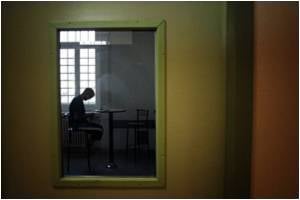Private space is increasingly at a premium these days

Design gurus at this year's Maison et Objet design fair in Paris were asked to think about privacy -- and what it means in a era defined by Facebook, mass media, reality television and cities mapped out by security cameras.
One concept on display cast the home as a cave or primitive shelter, a place we can crawl to "reconnect with our roots, our origins," said trendwatcher Elizabeth Leriche who imagined the space.
Raw-looking materials abounded, like lanterns or cabinets chiselled from rough stone, vases of leather or alabaster, or a Brazilian-made terracotta table that looked like a slab of cracked, dry-baked red earth, polished smooth.
"Privacy has become a luxury," Leriche said. "In a globalised world where everything moves so fast, we want to slow things down, get back in touch with nature, with the seasons -- and with the animal world."
This is "cocooning" -- the decade-old idea of the home as a safe, soothing nest -- but pushed to the extreme, and with a dose of humour thrown in as well.
Advertisement
Armchairs made from layered leather strips or undyed cow hide added to the animal theme, hammered home by the brooding presence of a taxidermied buffalo -- a star attraction at the fair, along with tigers, peacocks or a polar bear.
"The line between public and private is increasingly blurred. People want peace and quiet. They want comfort, but without cutting themselves off from the world altogether," said trendwatcher Francois Bernard.
"We are in the post-loft era. Everyone wants space, air, light, a view. Walls have come tumbling down, everything is open-space. Yet at the same time there is a need for privacy."
One way designers are resolving the paradox is by replacing walls with furniture to create temporary "bubbles", closed spaces in an open environment that play on the notion of boundaries.
This year's fair showed the backs of chairs creeping up, their sides curling round to envelop the sitter, while bookshelves were used as space-dividers.
"Designers are creating portable living-room cubes. Bedheads are growing along the sides, encircling the space. All these alcoves create the sense of a small world, a private bubble," said Bernard.
Because the need for privacy does not stop at the front door, designers are also working on ways to let people carry their "bubble" with them into the outside world -- and technology has a big role to play.
"Cocooning was all about objects, about being safely at home surrounded by my things, my friends," said Bernard.
"This is about a feeling I have when I step outside, with a pair of Sennheiser earphones that filter out the ambient noise, wearing a nylon puffer jacket that is so light it can be worn inside and out."
Exemplifying the trend, the design fair devoted a large space to the latest hi-fi innovations.
"Decoration up until now was very visual, and memorial -- for the past 20 or 30 years, we revisited the 18th century, then the 19th, then the 1950s and the 1970s, then we started all over again," said Bernard.
"But now design is clearly moving towards something that is more about emotions. Sound, electronics, are a full part of this new kind of decoration, it is no longer about rows of pots and vases."
Source-AFP









